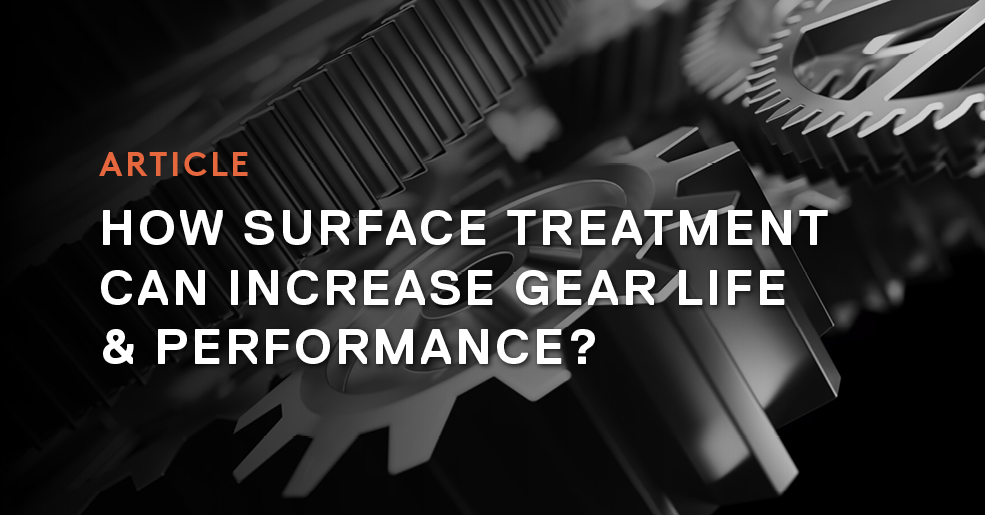A Comparison of Nitriding/Nitrocarburizing Versus Carburizing
Nitriding and nitrocarburizing hold many advantages that make them prime choices to produce high-quality gears. Some manufacturers might prefer carburizing as a case hardening method, especially for high-volume production, but nitriding and nitrocarburizing can often create more resistant and cost-efficient gears.
Each application or gear requires a specific heat or thermochemical surface treatment to increase surface hardness, reduce wear and improve fatigue resistance. Deciding which process to choose involves analyzing each application, as well as the type of point loading and gear design.
So, let’s explore the main differences between gas nitriding and carburizing since both are typically used to create high-value components.
Surface and Core Hardness
Even if nitriding and carburizing are both thermochemical treatments, each relies on very different mechanisms.
In nitriding, nitrogen diffusion hardens the surface; it changes the surface chemically but does not affect the core hardness.
The case on the surface of most nitrided steels “will be much harder and this hardness will carry into the depth of the part for a certain number of thousandths of an inch,” explains Jack Kalucki, technological advisor at Nitrex.
As for carburizing, it uses carbon diffusion to modify both core and surface hardness, and the amount of carbon and depth of diffusion will define the case. Carburized steels typically display a lower surface hardness, but a much deeper case. The core may be harder or softer depending on the type of treatment, the alloy, and the tempering temperature.
Temperatures and Sequence of Events
Another big difference between nitriding and carburizing involves the temperature and treatment sequence needed to process gears.
Carburizing operates at transformation-level temperatures above 800oC (1,500oF), whereas nitriding temperatures typically range between 400 and 600oC (750-1,100oF).
Moreover, carburizing always includes subsequent quench-and-temper treatment because it is performed above the transformation temperature. Carbon is diffused to harden cases, components are quenched, tempered, and inspected for growth and distortion, and final machining shapes the dimensions.
Oil quenching uses oil to cool down components very quickly and uniformly. With gas quenching, gases don’t act as perfectly, so very high pressure is used to mimic liquid. However, getting even flows of gases around parts is very difficult, especially in denser loads. To try to resolve these issues, manufacturers have resorted to techniques like single-part or single-layer gas quenching.
Nitriding doesn’t necessitate quenching. Gear materials are selected depending on torque, loading, and speed. The process includes steel hardening and tempering, rough machining, stress relief, final machining, and nitriding.
Steel Quality
Most quality gears are made from wear-resistant alloy steels specifically formulated for nitriding – known as nitralloys – because alloying elements (chromium, vanadium, molybdenum, etc.) combine with nitrogen to increase hardness and toughness.
European grade nitralloys offer a much higher chromium content for a harder surface and case depth. For North American gears, low-alloy steels such as 4140 and 4340 are typically used. Tool steels like H13 are also used for gearboxes or other applications. Some stainless steels, such as precipitation-hardened 17-4 PH, are also used in the manufacturing of aerospace gearing applications but on a much lower scale.
As for carbon, it doesn’t combine with alloying elements for hardness. In fact, carburizing can decrease the hardness range and require final machining to improve a component’s quality.
Since gears are often made with quenched-and-tempered materials, carbon amounts define the possible core hardness. Extremely low-carbon steels with less than 0.3% of carbon are quite common. The best carburizing steels are usually alloyed or highly alloyed, but a whole family of other carbon steels is also frequently used.
Wear and Corrosion Resistance
Gas nitriding forms white layers that improve toughness, lubricant retention, sliding wear resistance, and corrosion resistance. This prevents micro welding and produces quieter gears.
As for carburizing, it doesn’t improve sliding wear resistance because of poor tribology (i.e., how lubrication and friction impact the wear of interacting moving surfaces), nor does it improve corrosion resistance. However, since most gears are oiled, they don’t require high resistance to corrosion.
Distortion
In heat treatment, distortion affects a finished part’s dimensions.
Some degree of distortion can always be expected from carburizing. Past the critical temperature threshold, the material grows and distorts. Quenching only adds to this phenomenon. The best way to control distortion is probably press quenching but it is rather costly. A fixture is created to surround a part and hold its shape and prevent it from distorting.
With nitriding, distortion is negligible. And if stress relief is done properly, there may be very negligible growth and no distortion. Temperatures are lower, so distortion can be controlled by relieving the stresses imparted by rough machining into the steel.
Bending and Pitting Stress
Pitting resistance is typically somewhat similar between gas-nitrided and carburized materials. However, bending fatigue resistance is improved with nitriding because of compressive stress generated by the process. Carburized components require shot peening, a process used in many applications in the automotive industry, to produce compressive stress on the surface for more enduring parts.
Even though carburizing usually produces a harder core, compressive stress is extremely high for nitriding and much lower for carburizing. This explains why nitrided components can naturally better withstand bending.
Considering the combination of bending stress resistance and surface hardness, specially formulated high-quality nitrided steels, like 9310 that contains chromium, nickel, and molybdenum, compare very well even to better carburized steels, but they show a somewhat lesser contact or pitting stress limit.
In rare applications, such as in agriculture or military, a dual process can be performed where a component is first carburized and then nitrided. The nitriding process will yield a much harder surface but also produce compressive stress to help withstand higher bending fatigue. Nitriding can be done at temperatures below 400oC (750oF) to avoid tempering the carburized component.
Comparing Costs
Studies have shown gas nitriding to be very cost-competitive, especially when processing large loads. For example, in a 2010 article published in Gear Solutions magazine, Bugliarello et al. highlighted that carburizing produces the best dimensional properties with press quenching. Yet, if done correctly, nowadays, nitriding has less distortion and costs less than carburizing with press quenching.
Automotive Industry
Both electrical and combustion engine vehicles require gear surface treatment.
For example, low-pressure carburizing is used to heat treat planetary gearboxes for Illini Formula Electric’s line of all-electric race cars. A single-speed transmission uses a compound gearbox at each wheel.
Engineers at the company said that planetary gears were chosen because they “distribute the load over more teeth, allowing for a higher total load and torque capacity.”
The choice was also heavily based on higher gear volume and weight reduction.
NITREG® Technology
When it comes to gears, Nitrex’s controlled NITREG® nitriding and NITREG®-C nitrocarburizing technologies can be highly beneficial for the automotive industry as well as other sectors. Here are some advantages:
– Optimum and consistent gear properties
– Improvement of gear tribological properties
– Best alternative to eliminate gear distortion (noise reduction)
– Cost-effectiveness: eliminates/reduces several finishing operations (washing, inspection, hard finish machining, etc.)
– Similar bending stress limits and contact fatigue resistance to carburizing
– Environmentally friendly
Note: The use of nitriding steel is required for highly loaded applications as it may be sensitive to overloading.
This article is based on the comments of Jack Kalucki, technological advisor at Nitrex, and Mark Hemsath, Vice President of Sales, Heat Treating Services America, during a webinar held in March 2022.
Missed the webinar or want to rewatch it?
▶ Tune in here to replay!


